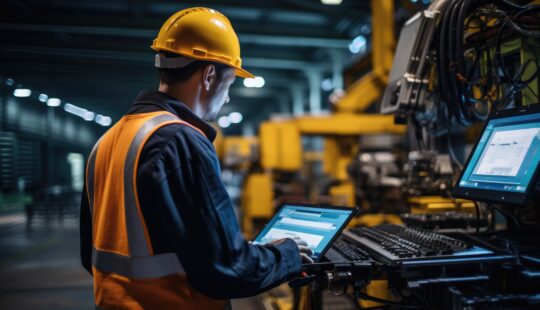It is the 2 April, 2020 and the world is gripped by the Covid-19 pandemic. The global supply chain is experiencing a level of disruption that has never been seen before. Some manufacturers have ceased production completely, some have seen greatly reduced demand and others have seen a huge increase in demand. Every manufacturer is impacted by this crisis in some way and for many this poses an existential threat.
Prior to the crisis, Industry 4.0 was an area of great interest to many manufacturers. It was an exciting topic with huge potential benefits and was seen by many as a ‘positive’ and future thinking topic.
Today, many of us are focussed on the here and now. Our health and the health of our family, friends and colleagues. The ability to access the food and supplies we need. Our job security. The financial impact on our employers, our clients and our partners. Beyond that we also have to consider the wider economic impact and the unknown amount of time it will take for things to return to some level of normality.
At this point in time it seems insensitive and inappropriate to discuss Industry 4.0 in the way it was discussed pre crisis. The business drivers of Industry 4.0 pre crisis were focussed on competitive advantage, cost reduction, productivity, sustainability and innovation.
The goal was to make well run businesses run better.
The focus for many manufacturers now is survival first and foremost and then beyond that, damage limitation.
The immediate financial impact on manufacturers is already resulting in a huge reduction in non-essential spending and investments. Many Industry 4.0 solutions currently being considered or being deployed fall into the category of non-essential business activities.
This raises a few challenging questions that I have asked myself as someone dedicated to manufacturing and Industry 4.0:
Is Industry 4.0 even a topic manufacturers should be thinking about?
Is Industry 4.0 relevant anymore?
If it is relevant, why is it relevant and what role does it have to play moving forward?
The short answer is yes, I believe Industry 4.0 is not only as relevant as it was before, I believe it is actually far more relevant moving forward and I would like to explain why.
The priorities for most manufacturers today fall into three distinct phases:
- Phase 1 Survival
- Phase 2 Recovery
- Phase 3 Business as Usual in the new post crisis paradigm
The goal for all manufacturers will be to get to Phase 3 as soon as possible and at the lowest cost. In defining the operating model for Phase 3 they will factor in lessons learned from the crisis and try to build a more resilient and agile business. They will be asking themselves some fundamental questions such as:
- Where were the weaknesses?
- Where did they make costly decisions and why?
- What would have helped?
I believe that the key finding will be that the systems and processes in place were not fit for purpose. It is too early to say for certain, but it seems clear from events unfolding before us that one of the major weaknesses is a lack of real time visibility across the business. Visibility that is essential to support critical business decisions. Examples are:
- What is the demand for products and where can we manufacture them?
- What are our current raw material, WIP and finished goods inventory levels?
- What is our manufacturing capacity, both in terms of human resources and asset availability?
- What is our spare part inventory and where are they?
- Where are our raw material shipments and what alternatives do we have?
- How is our finished goods distribution network operating?
Most system architectures currently consist of a heterogenous mix of applications and data silos. This architecture results in latency of information and a lack of a single real-time view of the business status. As soon as this architecture was tested beyond its normal operating conditions it failed, and this is why it is not fit for purpose.
I believe that another key learning from the crisis will be driven by manufacturers’ reliance on human capital and the impacts of social distancing. If we go one level deeper than the supply chain view then manufacturing in particular will be highlighted as a big area for improvement.
During the crisis, production plans will have been changing on a much higher frequency as a result of changing demands, availability of raw materials, availability of key staff and availability of assets. Manufacturing has a much higher volume and frequency of ‘transaction’ than the supply chain. Manufacturing is real-time, not near real-time.
As I write this today, the recovery phase is still an unknown amount of time away on the horizon.
When manufacturers do begin to move into the recovery phase, they will still be asking the same questions they are asking during the crisis highlighted above.
Eventually, we will reach the new normality and manufacturers will be keen to make sure this cannot happen again.
The role of Industry 4.0 in the future
Industry 4.0 has a different role from today onwards. Its role should be:
- Help to make sure that more companies survive
- Shorten the recovery phase and help return businesses to normal operations as soon as possible
- Provide the platform to develop new, more resilient businesses in the medium to long term
Industry 4.0 can achieve this because many of the capabilities it offers could have greatly reduced the impact of this crisis on us all. Just a few examples are:
- Real-time visibility into the availability of raw materials, finished goods, WIP, people and assets
- Use of Artificial Intelligence and Machine Learning to constantly reassess and re-plan activities
- Robotic Process Automation to support nonvalue add labour intensive activities
- The use of mobile technology, Augmented Reality and Virtual Reality to enable workers to perform tasks they were not trained for more easily. This could have assisted with skills shortages due to self-isolation or repurposing of manufacturing
- The same technologies together with digital twins and remote support from OEM’s would improve availability of assets
- The same technologies could also have enabled more remote working and virtual working to help with the issue of lockdown and social distancing
- 3D printing of spare parts that were stuck in the supply chain
- Use of AGV’s, autonomous electric vehicles and drones to again reduce the reliance on people and to further assist with social distancing.
Many of these technologies and solutions were seen as a nice to have. Many were waiting to ‘cross the chasm’ into mainstream adoption.
Rather than retreating away from them, I believe we should be thinking about how we can use these technologies now and in the future.
Can any be deployed to help deal with the crisis?
Beyond that, how can they be used to help us recover more quickly and develop more resilient and robust businesses that are better equipped to deal with this level of disruption in the future?
There is one other critical factor in navigating our way out of this. I have felt for a very long time that the key to successful digital transformation was not technology but collaboration.
We need to break down the traditional silos both within organisations and in the external supplier ecosystem. I don’t think this has ever been truer than it is today and the fact that I can see it happening in so many different areas gives me a lot of hope.
I do not have all of the answers, none of us do. What I do have are lots of ideas, a desire to make a difference and a willingness to listen.
*In this time of uncertainty, we are opening access to technologies that can help employees, companies, communities, and governments continue to move forward.
This article first appeared in The Manufacturer here.



